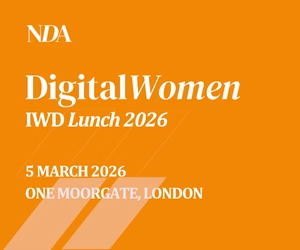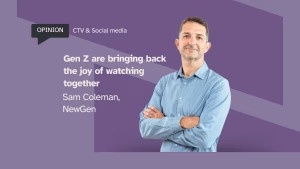The fragmentation of the media marketplace creates challenges not only for modern marketers, but also for the broadcasters and publishers they work with. One constantly evolving challenge is ‘measurement’ – for example, when TV and video content is being consumed across a wide range of channels, platforms and devices, how can you accurately assess the reach and success of your campaigns?
New Digital Age, in association with Comscore, recently invited industry leaders from some of the UK and Europe’s leading broadcasters to discuss the issues surrounding measurement in more detail.
NDA editor Justin Pearse chaired the conversation, where he was joined by (among others): Aurélie Brunet de Courssou, Marketing Director, RTL AdAlliance; Zach Belmont, VP, International Programmatic Revenue, Paramount; Nat Poulter, VP, Digital – Commercial, BBC Studios; Frazer Locke, Director EU & APAC AdTech Sales, Amazon Ads; and Colin Burrows, Senior Sales Director at Comscore.
Opening the conversation, Burrows outlined how the increasingly fragmented media landscape impacts media owners and advertisers and their efforts at measurement.
“There’s still a focus on fairly traditional metrics, in that ‘reach’ and ‘frequency’ still dominate marketers’ thinking. However, from a broadcaster or publisher’s perspective, even a basic metric like ‘reach’ can be challenging to measure accurately. For example, consider the variety of ways a person might consume TV news content be it on linear TV, CTV, online or, crucially, via one of the big social media platforms.”
As a result, said Burrows, there is an increased focus on ‘incremental reach’ to help publishers better understand how people are consuming their content across different devices and different platforms.
“Our latest solution Social Incremental allows publishers and broadcasters to deduplicate their reach across the major social platforms and then combine their social footprint and digital footprint to more accurately calculate overall reach.“
Belmont agreed that, in terms of KPIs, reach and frequency remain the “common currency” for advertisers but added that this becomes incredibly difficult when you are attempting to measure across international markets.
“If you have a campaign running in the UK, Germany and Spain, you won’t be able to deploy the same measurement partner across those territories. Another problem is that the big walled gardens won’t share their data, so It becomes challenging to come to a holistic view across an entire campaign.
“A hangover from programmatic on mobile and web is that advertisers regard a household as a single user on CTV. In reality, there may be four different people in that household, all with different interests, who are generating multiple viewing sessions throughout the day. We need a more sophisticated ‘household’ offering that reflects that reality.”
Differing interests
Poulter of BBC Studios commented: “Social media platforms have grown up with the ability to track everything and, as a result, ads on social channels have always been very performance orientated, trying to drive a purchase almost immediately. There’s a temptation to replicate that in other channels as they come online but I think that would be a mistake in the case of TV.
“We need to start building awareness at the top of the funnel again. We need brand campaigns and performance campaigns to be working together, otherwise, you’re going to keep nailing the same people at the bottom of the funnel over and over again.”
Poulter added: “Right now, I’m seeing more people looking at metrics like Lifetime Value and Churn. If you’re delivering that awareness at the top of the funnel and spending more time interacting with your customers, you’re going to churn less.”
The differing interests of broadcasters, online platforms and social networks are the key barrier to any form of unified measurement standards in relation to TV and video, according to Brunet de Courssou of RTL AdAlliance.
“Advertisers would prefer that we all agree on what counts as a ‘view’ but there’s no real motivation for all players involved to agree on one metric for everything. An ad view on broadcast TV or within premium CTV content on a smart TV may not be worth the same as a view within digital mobile environments for example.”
Another issue, said Brunet de Courssou, is that sometimes advertisers ask for measurement just for the sake of receiving some numbers, without really understanding what it is that they actually need.
“The media marketplace is very complex and not all marketers are media experts, which can lead to confusion around measurement. For example, a lot of people at the moment are asking whether their campaigns have achieved an incremental reach, but if you haven’t planned your campaign with incremental reach in mind, it’s extremely difficult to determine. If incremental reach is genuinely an important KPI for you, you need to plan accordingly.”
Locke spoke of the trends he is seeing among Amazon Ads customers and how he is working to help brands better understand the impact of their campaigns.
“Generally speaking, there’s an increasing focus on engagement. Our mantra is ‘audience first’ and we’re seeing more brands explore ‘lookalike audiences’ to scale their campaigns up using learnings from previous campaigns and audiences they’ve already engaged with.
“In terms of clients having their own clear KPIs, we’re seeing a blurring of the lines between awareness campaigns and performance campaigns. The silos are beginning to break down and smaller independent agencies are adapting quickly to meet the needs of brands wanting to better understand how their awareness campaigns impact traditional performance metrics.”
Locke believes that, as an industry, broadcasters could be doing more to “join hands” and standardise measurement where it can: “You’re not going to get everybody committing to everything, but there’s probably a basic set of concepts that could be agreed as the foundation of some sort of gold standard.
“Conversations like the one we’re having today could be the start of that.”










